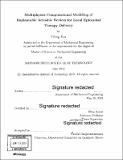Multiphysics computational modeling of implantable actuable devices for local epicardial therapy delivery
Author(s)
Fan, Yiling,S.M.Massachusetts Institute of Technology.
Download1117714488-MIT.pdf (11.22Mb)
Other Contributors
Massachusetts Institute of Technology. Department of Mechanical Engineering.
Advisor
Ellen Roche.
Terms of use
Metadata
Show full item recordAbstract
Over the past few decades, heart disease remainis the leading cause of death globally. Local myocardial delivery of cardiac therapies is a potential method to improve the efficiency and expand the variety of cardiac therapies due to its capability of providing high local concentrations with minimal systemic exposure. Recently, our group has developed two epicardial (outer wall of the heart) delivery devices, called "Therepi" and "fibRobot", that are implantable, replenishable and actuatable. They have the potential to improve the efficiency of drug delivery by enabling the capability of giving multiple dose of therapies with only one implantation surgery and reducing the foreign body responses through mechanical oscillation. In this thesis, we used different computational models (structural, drug diffusion, and fluid-structure interaction) to characterize the therapeutic effect of these two devices on the heart. We also used the validated computational models to evaluate iterative designs of each device and purpose an optimization work-flow for these devices. The drug transport model showed anisotropic diffusion in the myocardium with increasing diffusivity along fiber orientation. Transmural penetration was slow in the model, taking over 5 days to diffuse through the left ventricular wall. Various design evaluations showed that the transmural penetration speed can be improved by increasing the area of the reservoir-epicardium interface. Seperately, in a the structural model, we showed that "fibRobot " can provide 7% of strain on to its lower membrane during actuation. The model also showed that, if higher strain is required in order to modulate the foreign body response, we will need to either increase the actuation pressure, increase the membrane radius, reduce the membrane thickness, or reduce the membrane stiffness. In the future, we plan to couple these models to a multiphysics model to thoroughly characterize the drug transport from our epicardial device to the heart.
Description
Thesis: S.M., Massachusetts Institute of Technology, Department of Mechanical Engineering, 2019 Cataloged from PDF version of thesis. Includes bibliographical references (pages 73-79).
Date issued
2019Department
Massachusetts Institute of Technology. Department of Mechanical EngineeringPublisher
Massachusetts Institute of Technology
Keywords
Mechanical Engineering.